Xiaoshuai Sun
CIR-CoT: Towards Interpretable Composed Image Retrieval via End-to-End Chain-of-Thought Reasoning
Oct 09, 2025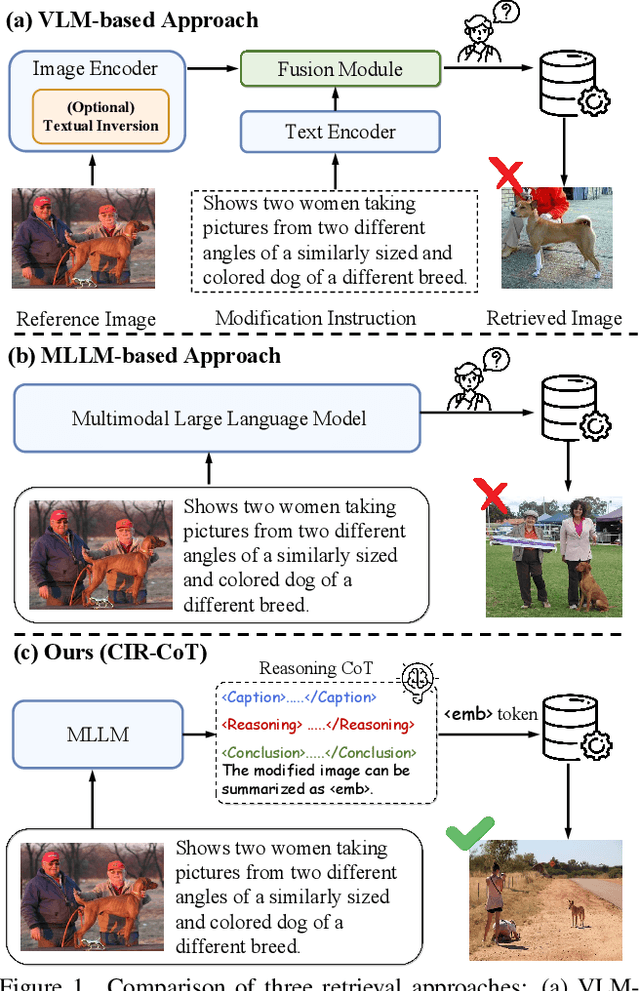
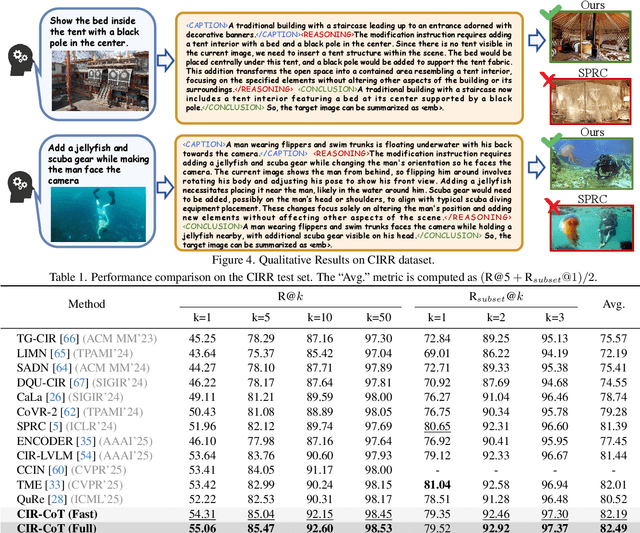
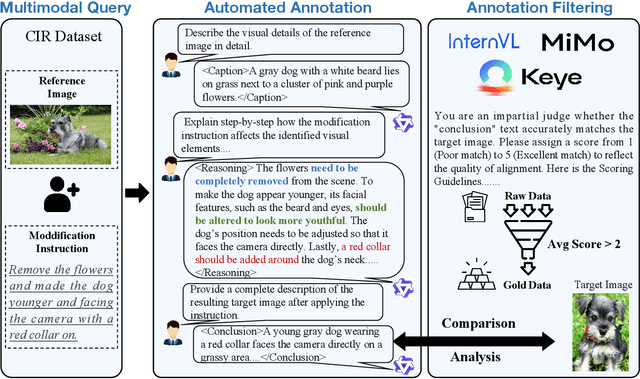
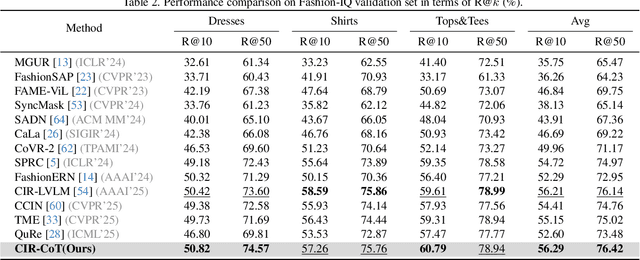
Abstract:Composed Image Retrieval (CIR), which aims to find a target image from a reference image and a modification text, presents the core challenge of performing unified reasoning across visual and semantic modalities. While current approaches based on Vision-Language Models (VLMs, e.g., CLIP) and more recent Multimodal Large Language Models (MLLMs, e.g., Qwen-VL) have shown progress, they predominantly function as ``black boxes." This inherent opacity not only prevents users from understanding the retrieval rationale but also restricts the models' ability to follow complex, fine-grained instructions. To overcome these limitations, we introduce CIR-CoT, the first end-to-end retrieval-oriented MLLM designed to integrate explicit Chain-of-Thought (CoT) reasoning. By compelling the model to first generate an interpretable reasoning chain, CIR-CoT enhances its ability to capture crucial cross-modal interactions, leading to more accurate retrieval while making its decision process transparent. Since existing datasets like FashionIQ and CIRR lack the necessary reasoning data, a key contribution of our work is the creation of structured CoT annotations using a three-stage process involving a caption, reasoning, and conclusion. Our model is then fine-tuned to produce this structured output before encoding its final retrieval intent into a dedicated embedding. Comprehensive experiments show that CIR-CoT achieves highly competitive performance on in-domain datasets (FashionIQ, CIRR) and demonstrates remarkable generalization on the out-of-domain CIRCO dataset, establishing a new path toward more effective and trustworthy retrieval systems.
MIHBench: Benchmarking and Mitigating Multi-Image Hallucinations in Multimodal Large Language Models
Aug 01, 2025Abstract:Despite growing interest in hallucination in Multimodal Large Language Models, existing studies primarily focus on single-image settings, leaving hallucination in multi-image scenarios largely unexplored. To address this gap, we conduct the first systematic study of hallucinations in multi-image MLLMs and propose MIHBench, a benchmark specifically tailored for evaluating object-related hallucinations across multiple images. MIHBench comprises three core tasks: Multi-Image Object Existence Hallucination, Multi-Image Object Count Hallucination, and Object Identity Consistency Hallucination, targeting semantic understanding across object existence, quantity reasoning, and cross-view identity consistency. Through extensive evaluation, we identify key factors associated with the occurrence of multi-image hallucinations, including: a progressive relationship between the number of image inputs and the likelihood of hallucination occurrences; a strong correlation between single-image hallucination tendencies and those observed in multi-image contexts; and the influence of same-object image ratios and the positional placement of negative samples within image sequences on the occurrence of object identity consistency hallucination. To address these challenges, we propose a Dynamic Attention Balancing mechanism that adjusts inter-image attention distributions while preserving the overall visual attention proportion. Experiments across multiple state-of-the-art MLLMs demonstrate that our method effectively reduces hallucination occurrences and enhances semantic integration and reasoning stability in multi-image scenarios.
AIGI-Holmes: Towards Explainable and Generalizable AI-Generated Image Detection via Multimodal Large Language Models
Jul 03, 2025Abstract:The rapid development of AI-generated content (AIGC) technology has led to the misuse of highly realistic AI-generated images (AIGI) in spreading misinformation, posing a threat to public information security. Although existing AIGI detection techniques are generally effective, they face two issues: 1) a lack of human-verifiable explanations, and 2) a lack of generalization in the latest generation technology. To address these issues, we introduce a large-scale and comprehensive dataset, Holmes-Set, which includes the Holmes-SFTSet, an instruction-tuning dataset with explanations on whether images are AI-generated, and the Holmes-DPOSet, a human-aligned preference dataset. Our work introduces an efficient data annotation method called the Multi-Expert Jury, enhancing data generation through structured MLLM explanations and quality control via cross-model evaluation, expert defect filtering, and human preference modification. In addition, we propose Holmes Pipeline, a meticulously designed three-stage training framework comprising visual expert pre-training, supervised fine-tuning, and direct preference optimization. Holmes Pipeline adapts multimodal large language models (MLLMs) for AIGI detection while generating human-verifiable and human-aligned explanations, ultimately yielding our model AIGI-Holmes. During the inference stage, we introduce a collaborative decoding strategy that integrates the model perception of the visual expert with the semantic reasoning of MLLMs, further enhancing the generalization capabilities. Extensive experiments on three benchmarks validate the effectiveness of our AIGI-Holmes.
RePrompt: Reasoning-Augmented Reprompting for Text-to-Image Generation via Reinforcement Learning
May 23, 2025Abstract:Despite recent progress in text-to-image (T2I) generation, existing models often struggle to faithfully capture user intentions from short and under-specified prompts. While prior work has attempted to enhance prompts using large language models (LLMs), these methods frequently generate stylistic or unrealistic content due to insufficient grounding in visual semantics and real-world composition. Inspired by recent advances in reasoning for language model, we propose RePrompt, a novel reprompting framework that introduces explicit reasoning into the prompt enhancement process via reinforcement learning. Instead of relying on handcrafted rules or stylistic rewrites, our method trains a language model to generate structured, self-reflective prompts by optimizing for image-level outcomes. The tailored reward models assesse the generated images in terms of human preference, semantic alignment, and visual composition, providing indirect supervision to refine prompt generation. Our approach enables end-to-end training without human-annotated data. Experiments on GenEval and T2I-Compbench show that RePrompt significantly boosts spatial layout fidelity and compositional generalization across diverse T2I backbones, establishing new state-of-the-art results.
Zooming In on Fakes: A Novel Dataset for Localized AI-Generated Image Detection with Forgery Amplification Approach
Apr 16, 2025Abstract:The rise of AI-generated image editing tools has made localized forgeries increasingly realistic, posing challenges for visual content integrity. Although recent efforts have explored localized AIGC detection, existing datasets predominantly focus on object-level forgeries while overlooking broader scene edits in regions such as sky or ground. To address these limitations, we introduce \textbf{BR-Gen}, a large-scale dataset of 150,000 locally forged images with diverse scene-aware annotations, which are based on semantic calibration to ensure high-quality samples. BR-Gen is constructed through a fully automated Perception-Creation-Evaluation pipeline to ensure semantic coherence and visual realism. In addition, we further propose \textbf{NFA-ViT}, a Noise-guided Forgery Amplification Vision Transformer that enhances the detection of localized forgeries by amplifying forgery-related features across the entire image. NFA-ViT mines heterogeneous regions in images, \emph{i.e.}, potential edited areas, by noise fingerprints. Subsequently, attention mechanism is introduced to compel the interaction between normal and abnormal features, thereby propagating the generalization traces throughout the entire image, allowing subtle forgeries to influence a broader context and improving overall detection robustness. Extensive experiments demonstrate that BR-Gen constructs entirely new scenarios that are not covered by existing methods. Take a step further, NFA-ViT outperforms existing methods on BR-Gen and generalizes well across current benchmarks. All data and codes are available at https://github.com/clpbc/BR-Gen.
An Efficient and Mixed Heterogeneous Model for Image Restoration
Apr 15, 2025Abstract:Image restoration~(IR), as a fundamental multimedia data processing task, has a significant impact on downstream visual applications. In recent years, researchers have focused on developing general-purpose IR models capable of handling diverse degradation types, thereby reducing the cost and complexity of model development. Current mainstream approaches are based on three architectural paradigms: CNNs, Transformers, and Mambas. CNNs excel in efficient inference, whereas Transformers and Mamba excel at capturing long-range dependencies and modeling global contexts. While each architecture has demonstrated success in specialized, single-task settings, limited efforts have been made to effectively integrate heterogeneous architectures to jointly address diverse IR challenges. To bridge this gap, we propose RestorMixer, an efficient and general-purpose IR model based on mixed-architecture fusion. RestorMixer adopts a three-stage encoder-decoder structure, where each stage is tailored to the resolution and feature characteristics of the input. In the initial high-resolution stage, CNN-based blocks are employed to rapidly extract shallow local features. In the subsequent stages, we integrate a refined multi-directional scanning Mamba module with a multi-scale window-based self-attention mechanism. This hierarchical and adaptive design enables the model to leverage the strengths of CNNs in local feature extraction, Mamba in global context modeling, and attention mechanisms in dynamic feature refinement. Extensive experimental results demonstrate that RestorMixer achieves leading performance across multiple IR tasks while maintaining high inference efficiency. The official code can be accessed at https://github.com/ClimBin/RestorMixer.
Exploring the Collaborative Advantage of Low-level Information on Generalizable AI-Generated Image Detection
Apr 01, 2025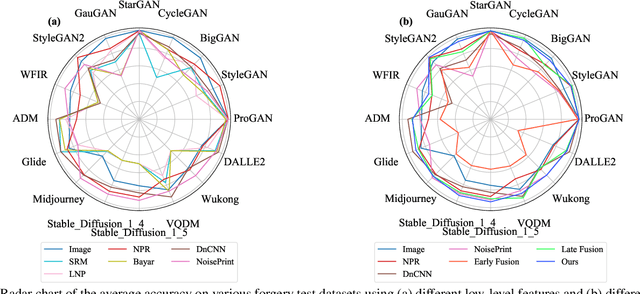
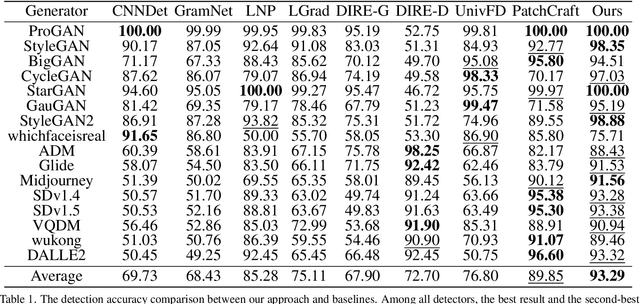
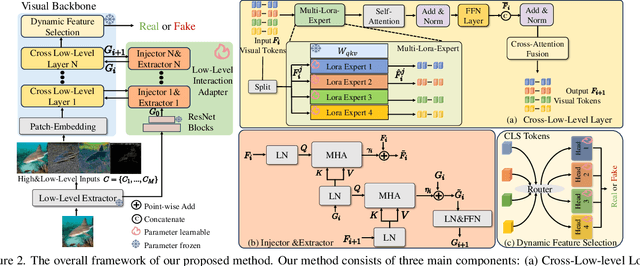

Abstract:Existing state-of-the-art AI-Generated image detection methods mostly consider extracting low-level information from RGB images to help improve the generalization of AI-Generated image detection, such as noise patterns. However, these methods often consider only a single type of low-level information, which may lead to suboptimal generalization. Through empirical analysis, we have discovered a key insight: different low-level information often exhibits generalization capabilities for different types of forgeries. Furthermore, we found that simple fusion strategies are insufficient to leverage the detection advantages of each low-level and high-level information for various forgery types. Therefore, we propose the Adaptive Low-level Experts Injection (ALEI) framework. Our approach introduces Lora Experts, enabling the backbone network, which is trained with high-level semantic RGB images, to accept and learn knowledge from different low-level information. We utilize a cross-attention method to adaptively fuse these features at intermediate layers. To prevent the backbone network from losing the modeling capabilities of different low-level features during the later stages of modeling, we developed a Low-level Information Adapter that interacts with the features extracted by the backbone network. Finally, we propose Dynamic Feature Selection, which dynamically selects the most suitable features for detecting the current image to maximize generalization detection capability. Extensive experiments demonstrate that our method, finetuned on only four categories of mainstream ProGAN data, performs excellently and achieves state-of-the-art results on multiple datasets containing unseen GAN and Diffusion methods.
MLLM-Selector: Necessity and Diversity-driven High-Value Data Selection for Enhanced Visual Instruction Tuning
Mar 26, 2025Abstract:Visual instruction tuning (VIT) has emerged as a crucial technique for enabling multi-modal large language models (MLLMs) to follow user instructions adeptly. Yet, a significant gap persists in understanding the attributes of high-quality instruction tuning data and frameworks for its automated selection. To address this, we introduce MLLM-Selector, an automated approach that identifies valuable data for VIT by weighing necessity and diversity. Our process starts by randomly sampling a subset from the VIT data pool to fine-tune a pretrained model, thus creating a seed model with an initial ability to follow instructions. Then, leveraging the seed model, we calculate necessity scores for each sample in the VIT data pool to identify samples pivotal for enhancing model performance. Our findings underscore the importance of mixing necessity and diversity in data choice, leading to the creation of MLLM-Selector, our methodology that fuses necessity scoring with strategic sampling for superior data refinement. Empirical results indicate that within identical experimental conditions, MLLM-Selector surpasses LLaVA-1.5 in some benchmarks with less than 1% of the data and consistently exceeds performance across all validated benchmarks when using less than 50%.
Grounded Chain-of-Thought for Multimodal Large Language Models
Mar 17, 2025Abstract:Despite great progress, existing multimodal large language models (MLLMs) are prone to visual hallucination, greatly impeding their trustworthy applications. In this paper, we study this problem from the perspective of visual-spatial reasoning, and propose a new learning task for MLLMs, termed Grounded Chain-of-Thought (GCoT). Different from recent visual CoT studies, which focus more on visual knowledge reasoning, GCoT is keen to helping MLLMs to recognize and ground the relevant visual cues step by step, thereby predicting the correct answer with grounding coordinates as the intuitive basis. To facilitate this task, we also carefully design and construct a dataset called multimodal grounded chain-of-thought (MM-GCoT) consisting of 24,022 GCoT examples for 5,033 images. Besides, a comprehensive consistency evaluation system is also introduced, including the metrics of answer accuracy, grounding accuracy and answer-grounding consistency. We further design and conduct a bunch of experiments on 12 advanced MLLMs, and reveal some notable findings: i. most MLLMs performs poorly on the consistency evaluation, indicating obvious visual hallucination; ii. visual hallucination is not directly related to the parameter size and general multimodal performance, i.e., a larger and stronger MLLM is not less affected by this issue. Lastly, we also demonstrate that the proposed dataset can help existing MLLMs to well cultivate their GCoT capability and reduce the inconsistent answering significantly. Moreover, their GCoT can be also generalized to exiting multimodal tasks, such as open-world QA and REC.
AdaFlow: Efficient Long Video Editing via Adaptive Attention Slimming And Keyframe Selection
Feb 08, 2025Abstract:Despite great progress, text-driven long video editing is still notoriously challenging mainly due to excessive memory overhead. Although recent efforts have simplified this task into a two-step process of keyframe translation and interpolation generation, the token-wise keyframe translation still plagues the upper limit of video length. In this paper, we propose a novel and training-free approach towards efficient and effective long video editing, termed AdaFlow. We first reveal that not all tokens of video frames hold equal importance for keyframe translation, based on which we propose an Adaptive Attention Slimming scheme for AdaFlow to squeeze the $KV$ sequence, thus increasing the number of keyframes for translations by an order of magnitude. In addition, an Adaptive Keyframe Selection scheme is also equipped to select the representative frames for joint editing, further improving generation quality. With these innovative designs, AdaFlow achieves high-quality long video editing of minutes in one inference, i.e., more than 1$k$ frames on one A800 GPU, which is about ten times longer than the compared methods, e.g., TokenFlow. To validate AdaFlow, we also build a new benchmark for long video editing with high-quality annotations, termed LongV-EVAL. Our code is released at: https://github.com/jidantang55/AdaFlow.
 Add to Chrome
Add to Chrome Add to Firefox
Add to Firefox Add to Edge
Add to Edge